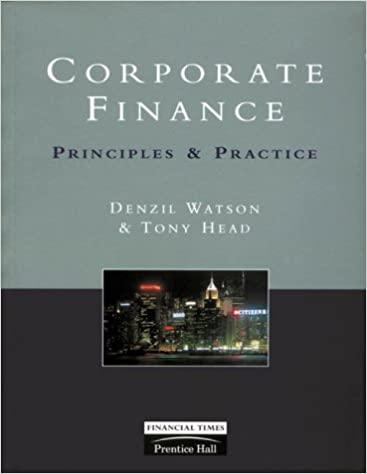Question
Based on the tenets of utility theory, people can be shown to: A. Derive positive utility from additions to their wealth. B. Derive positive utility
Based on the tenets of utility theory, people can be shown to:
A. Derive positive utility from additions to their wealth.
B. Derive positive utility from risk.
C. Derive negative utility from additions to their wealth.
D. Derive negative utility from risk.
E. Both A and B. F. Both A and D,
2. Which of the following does NOT seem to support the fundamental financial tenet that rational people are risk averse?
A. People buy insurance.
B. People gamble.
C. People hedge their risks.
D. People diversify their portfolios.
E. Both A and B. F. Both C and D.
3. The term "loss severity" is another name for:
A. Loss given default.
B. Legal risk.
C. Operational risk.
D. Market risk.
E. Risk identification.
4. In a risk management (RM) process certain steps should be taken in a certain order. The steps, not necessarily in order, are:
1. manage the risks using appropriate RM tools
2. measure the risks.
3. identify the risks.
4. decide how much of each risk to bear.
The correct order for the RM Process is:
A. 1, 2, 3, 4 exactly as above.
B. 4, 1, 3, 2
C. 3, 2, 4, 1
D. 2, 1, 4, 3 5.
Which of the following might be a major risk to the airline industry as a whole:
A. Personnel risk.
B. Commodity price risk.
C. Pandemic risk.
D. Mortality/Longevity risk.
E. Both B and C. F.
Both A and D.
6. Which of the following moments of a distribution is a measure of symmetry?
A. Mean
B. Variance
C. Kurtosis
D. Skewness
7. Suppose that you believe that there is a relationship between variables Y, X, and W. Specifically, you believe that the relationship takes the form:
Y = aXbWc
You would like to estimates the three parameters, a, b, and c, of the equation using multiple linear regression. Which of the following is true:
A. You could take the natural logarithm of both sides to transform the equation to a linear form and then proceed to apply linear regression. The regression would produce a direct estimate of b and c, but you would have to apply the exponential function to your result to get a.
B. The equation is not linear so linear regression cannot be used to solve for the parameters.
C. The equation is linear so you could apply the linear regression directly to the data.
D. None of the above are true. Short Answer Questions:
8. Suppose that you believe that a stock's one-year expected return (i.e., mean) (continuous compounded) is 15% and that the one-year volatility (i.e., vol or standard deviation) is 24%. The stock's price is currently $35. Calculate the one year VaR (in terms of stock price) at 95%. Note, the stock does not pay dividends.
9. Suppose that you have four junk bonds and each has a 5 percent chance of defaulting over the next year. What is the probability that exactly two of four bonds will default over the next year? See Binomials
10. Suppose that the probability of a GM Bond defaulting this year and the price of gasoline reaching $5.00 per gallon 10%. The probability of the price of gasoline reaching $5.00 per gallon this year is 25%. What is the probability that GM defaults on the bond given that gasoline prices reach $5.00? See conditional probability =Joint/ Marginal 10/25=40%
11. Imagine that you randomly select five children in the local kindergarten and measure their heights in inches. You get the results below: Child Height 1 45 2 37 3 42 4 44 5 38 a. Calculate the sample mean=41.2 b. Using the same data as in the problem above, calculate the sample standard deviation. Use "T" not "T-1" as the divisor (where T is the sample size). Sqrt(Sum (x-u)^2/5) Sum =50.8 Ans=sqrt(10.16) =3.18
Step by Step Solution
There are 3 Steps involved in it
Step: 1

Get Instant Access to Expert-Tailored Solutions
See step-by-step solutions with expert insights and AI powered tools for academic success
Step: 2

Step: 3

Ace Your Homework with AI
Get the answers you need in no time with our AI-driven, step-by-step assistance
Get Started


